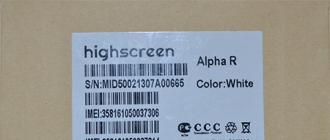What is the difference between Windows 7 Ultimate and Maximum? What versions of the Windows operating system are there? Video: how to find out the version of your operating system
Windows 7 was released for free sale in the fall of 2009 and has since become the most popular of all Microsoft operating systems. Let's try to figure out what innovations and improvements compared to its predecessors brought Windows 7 such popularity and love from numerous users around the world.
Improvements and innovations
A big gift for lovers of the latest technologies was the appearance of multi-touch control support. This technology allows you to control your touchscreen laptop with multiple finger movements at the same time. In addition, it recognizes various user gestures, making operation simple and intuitive. Windows 7 is tightly integrated with driver manufacturers for various devices. Thanks to this, users are relieved of the need to independently determine, search and install the necessary drivers; in most cases, the system will do this automatically.
Fans of older applications will be pleased with the compatibility mode with earlier operating systems, such as Windows XP. This means that users will be able to easily run games that were designed for previous versions of Windows.
The Windows 7 operating system includes a DirectX 11 installation package, which supports a number of new technologies in graphics processing. Users now have the opportunity to fully enjoy the magnificent picture on the computer screen, which is created thanks to improved tessellation mode and support for new compute shaders, as well as expanded ability to render images in multiple threads.
Finally, high-quality operation of the Windows Media Player built into the operating system has been realized, which this time received serial number 12. Previous versions of the program played only a limited number of video formats; to improve the work, the installation of a large number of codecs was required. Users did not like this approach, which is why they increasingly chose software from third-party manufacturers. In the latest version of the player, the list of supported video formats has been significantly expanded.
Windows 7 has received a modified, more convenient and functional taskbar. Now the panel displays only icons without labels, which allows you to fit many more applications on it at the same time. In addition, a “Collapse all windows” button has appeared on the panel.
It is now possible to manage the reserved disk space allocated for system recovery. The user can also determine what exactly should be restored - system settings, changed files, or all together.
Desktop gadgets in Windows 7 are no longer tied to a bar on the left side of the screen. The user can independently move them to any place convenient for him.
Windows 7 has expanded the list of fonts included by default. In addition, the fonts have been redesigned to correctly display various characters. The list of non-Latin fonts available to the user has been significantly expanded.
The Aero interface, known to users from the previous version of the Windows Vista operating system, now supports several design options. It also adds new features that let you easily manage the location and size of windows on your desktop.
Safety
Windows 7 provides greater security features for your personal computer. Now the user has access to the function of prohibiting the launch of individual applications using the AppLocker service. BitLocker encryption technology has undergone significant improvements and now allows you to encrypt information on removable media. The Windows Firewall has been significantly improved to notify the user when applications are blocked. Thanks to the DirectAccess function, it is now possible to establish a secure connection with a remote server without user intervention.
Editorial
Windows 7 has six different editions, which differ in functionality and cost.
Initial version or Windows 7 Starter characterized by limited functionality, for example, it does not even allow you to change the picture on the desktop. This edition of the operating system is supplied exclusively in the OEM version and, as a rule, was pre-installed on laptops and netbooks.
The next edition is called Windows 7 Home Basic and also has a very limited set of capabilities. It does not support the proprietary Windows Aero interface and Multitouch technology, and has little functionality when working with local networks. Designed for OEM sales and supplies to emerging markets.
The most popular versions were Windows 7 Professional and Home Premium. They are actively sold at retail, and are also pre-installed on a large number of computers assembled around the world. They support all the functions necessary for the average user; the functionality limitations affected only the segment necessary for working in large corporate networks and performing specific tasks.
The maximum range of capabilities is provided by the versions Windows 7 Ultimate and Enterprise. They are identical in functionality, but the first version is intended for retail sales, and the second for deliveries to corporate clients. Windows 7 Ultimate is the top version of the system, which includes absolutely all the features laid down by Microsoft developers.
Hardware requirements
To correctly install the operating system on the user’s computer, it must have the following: minimum characteristics:
- Processor with a frequency of at least 1 GHz;
- 1 gigabyte of RAM (2 gigabytes for the 64-bit version);
- A video adapter with a capacity of at least 128 megabytes (required to enable the Aero interface) and DirectX9 support;
- 16 gigabytes of free hard disk space (20 gigabytes for the 64-bit version).
Some users do this: having bought a new computer with a pre-installed starter or home version of Windows 7, without even starting to use it, they remove the “inferior” system in their opinion and install the maximum one instead. Or professional, without really understanding why it is better than what it was.
For some reason, many people believe that the Ultimate (maximum), Enterprise (corporate) and Professional (professional) versions of Windows 7 are better because “they have more features.” Although 90% of these features are not needed by home users, and the word “professional” in the name of the operating system release has not yet turned anyone into a professional.
So is Windows 7 maximum really better than Home Basic?
But no. And there are several reasons for this:
- the distribution of the starter and home editions of the seven takes up less space on the hard drive;
- the variety of functions in “uncut” versions of Windows 7 is a temptation to experiment with their settings, which without proper knowledge leads to a decrease in the level of security and often leads to system crash and loss of user data;
- missing functions of the initial editions, such as the Windows Aero or Windows Media Center interface, are easily compensated for by installing third-party themes and applications (“Personalization Pack”, multimedia software, etc.);
- many of the “bells and whistles” of full-fledged sevens are often not supported by the computer hardware on which the light version was installed by the manufacturer, and therefore are useless;
- for those who “choose the real thing” (licensed, not pirated) - the cost of full-featured editions is more than 4 times higher than stripped-down editions.

Minimal release, which contains only basic functions that provide solutions to basic problems when working on a computer. Manufacturers install Windows 7 Starter on entry-level netbooks and laptops with limited hardware resources. The Windows launch edition is not available for retail sale - it is distributed only under OEM licenses.
Among the shortcomings of this version, the most significant, from the point of view of users, are the following:
- 32-bit architecture only;
- support for RAM no more than 2 GB;
- inability to change the wallpaper on the desktop using the system;
- lack of support for a desktop manager with Windows Aero functionality (3D effects and transparency) and other personalization gadgets;
- inability to create a home group and virtual access point without the help of third-party tools;
- lack of a number of applications, such as Windows Media Center, “Scissors”, “Sticky Notes”, selected games.
- There is no support for gestures in touchpad control.
How to compensate for what is missing?
- Use 32-bit programs, which, fortunately, are no less numerous than 64-bit ones.
- Install a third-party application to change wallpaper and show slideshows on your desktop.
- To be able to admire the multi-color translucent window frames, install the personalization package.
- Use third-party hardware or software to create access points.
- Create a homegroup on another computer and join it.
- Use a mouse instead of a touchpad.
As for restrictions on the use of RAM, Windows 7 Starter is not installed on devices with more than 2 GB of RAM.
Windows 7 Home Basic and Premium

The basic and extended home versions have richer functionality than Windows 7 Starter. The extended edition, it can be argued, is capable of satisfying almost all the needs of a home user. Unlike Windows 7 Starter, Home Basic supports up to 8 GB of RAM and comes in 64-bit and 32-bit versions. The extended 64-bit home version supports up to 16 GB of RAM.
Home Basic still lacks:
- support for Windows Aero and a personalization panel (there is only a basic theme);
- Windows Media Center, Sticky Notes, Scissors, selected games;
- ability to create a home group.
But in it you can already change the wallpaper on your desktop and use your computer to provide Internet access to other devices (create a hosted network).

Windows 7 Home Premium has:
- desktop manager and Windows Aero interface with a full personalization package;
- support for up to 2 physical processors (Windows 7 Starter and Home Basic support one each);
- Windows Media Center and all types of standard applications provided;
- home group creation function;
- DVD playback and TV tuner support.
That is, the extended home version contains everything that Windows 7 Starter users lack.
Windows 7 Professional

Windows 7 Professional edition is designed for work and business. It has more developed data protection functionality and implements the possibility of use in large corporate networks. The 64-bit version of this system supports addressing up to 192 GB of RAM.
Windows 7 Professional also supports:
- data backup via the network with the ability to quickly restore;
- EFS – Encrypting File System;
- connecting to a domain (Windows 7 Starter and Home editions only support the creation of workgroups);
- Windows XP emulator (XP Mode) – a mode that provides the ability to run legacy applications in the built-in virtual machine (some types and types of business programs cannot be run in the Windows 7 environment);
- remote connection to a computer via RDP (Remote Desktop Connection);
- group policy editor (light versions of seven - from Windows 7 Starter to Home Advanced, also support group policy management, but only through direct entries to the registry);
- choosing the most convenient network printer;
- the possibility of downgrading (rollback) to Windows Vista or XP (valid until 2020).
The professional edition of the seven may be a justified choice for those who use the computer as a tool for making money. Thus, manufacturers of business-class laptops often install Windows 7 Professional on them.
Windows 7 corporate (Enterprise) and maximum (Ultimate)

The maximum and corporate editions have the same set of functions and differ only in the licensing scheme. Thus, Windows 7 Enterprise is not sold at retail and is not distributed under OEM licenses. Unlike the maximum, only corporate consumers can buy it.

In addition to what professional Windows 7 has, it implements:
- disk encryption technologies (Microsoft BitLocker and Microsoft BitLocker To Go) to protect data on any type of drive;
- expanded search capabilities in corporate networks (federal search);
- Microsoft AppLocker technology, which helps protect enterprise computers and networks from unauthorized launch and spread of malware;
- multilingual user environment (MUI), including 35 languages - for large transnational companies;
- ability to boot from a virtual disk – Microsoft Virtual PC;
- subsystem for launching UNIX applications;
- DirectAccess technology, which protects connections to corporate networks via the Internet;
- BranchCache technology to speed up data access on corporate file servers.
64-bit versions of Windows 7 Enterprise and Ultimate, like Professional, support addressing up to 192 GB of RAM. All 32-bit editions, starting with Home Basic, allow you to use only 4 GB of RAM, regardless of how much is installed on the computer. This limitation is due to the capabilities of the x86 architecture.
As you can see, the maximum editions of the seven implement technologies and solutions that are absolutely not needed by most home users. And the purpose of much of what is present here is understandable only to specialists. Therefore, if Windows 7 Starter is installed on your not-so-sophisticated netbook, think three times about whether it’s worth replacing it with a heavy, clumsy “tank”, most of the “bells and whistles” of which you will never need.
All editions, types and types of Windows 7 are equally worthy of being chosen. There are no good or bad ones among them - just each version has its own purpose.
Don't know which operating system is better: Windows 7 Ultimate or Professional? You have a difficult choice ahead of you, but you can definitely decide!
So which is better? Windows 7 Ultimate or Professional? In general, some experts believe that it is unreasonable to compare these two areas, because they both have certain criteria and improvements in different areas.
What operating systems are there on the Windows 7 platform? Basic option
There are currently 6 operating systems in total.
- Initial. The weakest platform, which does not support various extensions and generally has basic configurations. Its price varies between 2,000 rubles. Interestingly, it comes out only in 32-bit format, so for modern powerful computers this is the worst option, which does not even justify its price. In addition, it is not suitable for DVD playback or creation.
- Home Basic. It costs 2-3 times more than the previous one, but is well worth the money. Suitable for computers with low to medium performance. The most important difference is the presence of a performance center. 32 bit and 64 bit version.
These are the initial options that are most often installed on netbooks. They have reduced capabilities, the simplest functionality and interface. These operating systems are not recommended for use.
Middle option
Another version is Home Extended. Although it is not Windows 7 Ultimate 64 bit, it is quite good and worth the money.

- Home extended. This version is no longer basic; it costs about 6,000 rubles. The version is 64-bit, suitable for computers with average performance. This operating system has many graphical innovations, ranging from changing the home screen wallpaper to support for the Aero effect. Suitable for browser games and light strategies.
Overall, this is an ideal option for home use.
Professional option
And the best variations are Windows 7 Ultimate or Professional. What's better? Find out from the functionality and compare the possibilities!
- Professional. A more complex and developed version of the operating system that opens up new possibilities. The cost varies between 9,000 rubles, but the price is justified by a wide range of different new products. It is great for online and computer games. In general, it is designed to work with archivers and application packages.
- Maximum. Windows 7 Ultimate 64 bit is one of the best solutions to purchase. Price - 12,000 rubles. It has many useful functions that, at first glance, are completely unnecessary for the average user. Old improved features and completely new ones are the best choice. There are good 32-bit extensions, but with reduced functionality.

- Corporate. It differs from Maximum in several ways of activation on different devices connected via the network. Overall not worth the money. Experts almost always recommend choosing the Maximum operating system, because in the Corporate version not all applications may be free. It is perfect for use in large companies, and one user does not need this version.
In general, all systems are good for something specific. If you need a simple interface and legible functionality, then take a closer look at the initial versions. More complex, advanced parts require investment, but the result will definitely please you!
Which is better - Windows 7 Ultimate or Professional?
Once you've become familiar with the major platforms, it's time to learn more about each of them and make comparisons. What is special about the Professional and Maximum operating systems?
A professional operating system, or Professional, has the following characteristics:
- the price varies within 9,000 rubles;
- all applications that were launched on older versions can be launched in new editors;
- the version can be either 64-bit or 32-bit;
- if the version is 32-bit, then it has 4 GB of memory, but if it is 64-bit, then the amount of RAM reaches 192 GB;
- the operating system has 2 physical processors;
- function of emulation of outdated software, in particular Windows Vista;
- it is possible to encrypt data from intruders;
- advanced backup and recovery (it is possible to create an entire backup network within one system);
- Printing of paper documents is done taking into account the network location, hence, it helps to use various printers for both work and home use.

Windows 7 Ultimate 64 bit: description
The next step is a description of the 64-bit and 32-bit platforms of Windows 7 Ultimate.
The Maximum or Ultimate operating system has the following characteristics.
- Multi-stage and applications. Also protects data on external and internal storage devices.
- Technologies exist for secure network connections.
- Multilingual interface. In a comparison of Windows 7 Ultimate and Professional versions according to the criterion: “Language selection”, the Professional operating system wins.
- There is technology that makes accessing websites much faster.
- Protection against unlicensed software.
- The cost varies between 12,000 rubles.
- There are 2 types of version, the software characteristics are the same with the Professional version.
- What is the difference between Windows 7 Ultimate and Professional? Increased functionality and advanced data encryption methods.

Conclusion
Thus, we managed to find out which is better: Windows 7 Maximum or Professional for certain The most important differences are the price, which for the Maximum version is several times higher than the price of Professional and improved functionality. If you choose between Windows 7 Ultimate, which has quite a lot of positive reviews, and Professional, be sure to consider the purpose of the purchase. In addition, it is worth taking into account the specifics of your financial situation.
The Windows 7 operating system, by Microsoft, was presented in 6 editions. That is, there are a total of six different versions of the Windows 7 OS. But among such a large number, how can you decide which version to choose? You will learn about everything in order from this article. It's really simple!
So, to start with, here's a list, what versions of Windows 7 are there:
Initial
Home Basic
Home Extended
Professional
Corporate
Maximum
Let's look at each in more detail, and only then draw a conclusion that will easily help you decide which version of Windows 7 to choose.
Windows 7 Starter
You won't find this version of Windows 7 on store shelves, as it is intended only for computer manufacturers. Manufacturers, in turn, install this version on the cheapest and lowest-power computers. In terms of functionality, this version is the most limited: it does not have Aero effects, and it can only be 32-bit.
Windows 7 Home Basic
This version of Windows 7 also lacks some features, but it already has the Aero effect, with the exception of transparency and changing the desktop picture, and this version of the system can be purchased. It is also worth mentioning that Windows 7 Home Basic does not play DVDs.
Windows 7 Home Premium
Windows 7 Home Premium is the most common version among home users. It fully supports multimedia, has full support for Aero effects, allows you to install it on tablet computers, and accordingly supports touch controls.
Windows 7 Professional
It's like Home Advanced, but it contains even more features, such as remote control, an encrypted file system, and more. This version of Windows 7 is designed primarily for use by enterprises and small businesses.
Windows 7 Enterprise
This version of Windows, like the Starter version, is not intended for sale, but is provided to large enterprises and firms. This version provides additional features that can be very useful to companies, firms, organizations: encryption of disks and removable media (flash drives, external hard drives), many languages, program control and much more, which is not particularly interesting for us.
Windows 7 Ultimate
In principle, this is the same corporate version of Windows 7, only already intended for sale. This is the most functional version of Windows, it has absolutely all the functions.
 If you have a question, which Windows 7 to choose for home use, then the answer here is simple. I recommend choosing one of three versions of Windows 7.
If you have a question, which Windows 7 to choose for home use, then the answer here is simple. I recommend choosing one of three versions of Windows 7.
Home extended.
Professional.
Maximum.
For most users, the first one from the list is suitable, that is, the Home Premium version of Windows 7. Since if you are planning to purchase a license, it will cost you much less. Why spend more money on Windows Ultimate and then not use most of the features. Well, then, decide for yourself!
I will conclude here, and if you are interested in the question, which is already installed on your computer, then refer to the corresponding lesson using the link in this sentence.
Good luck choosing the version of Windows 7 for your PC.
The Windows 7 operating system comes in six editions. Having learned about their number, there is no need to grab your head and spend sleepless nights on the Internet, trying to determine the most suitable one. You will only have to choose from two, because the publications can be immediately divided into two categories. And in each of them, the choice will largely be dictated by the thickness of the wallet.
Operating systems for home
Windows 7 Starter
“Who needs such a system if you can’t run more than three programs in it?” - this is the first thing that comes to mind, if you don’t know that Microsoft is still refused from the idea of limiting the number of simultaneously running applications. Initially, the idea was that OEMs needed a cheap OS for installation on cheap netbooks equipped with a network card and/or Wi-Fi module. Imagine for a moment what you could do with three programs. Which one will you launch first? That's right, browser. And here for you:
- music and video
- newspapers, magazines and books
- collaboration with documents
- social networks, forums, chats, blogs, websites (where are you reading this article?)
- games and so on...
Considering the widespread shift of services to the Internet, you will have enough to do here for a long time. Not so bad for an ultra-cheap system, especially without a limit on the number of programs you can run. The edition is only available in 32-bit, which is not surprising given its entry level.
Windows 7 Home Basic
This edition has everything that is in the initial edition, and also adds a number of convenient features - Internet connection sharing, quick user switching, and a mobility center. And this significantly expands the range of computers on which OEMs will install Home Basic. These so-called budget desktop and mobile computers will go to emerging markets. Yes, this edition doesn't have some of the goodies of the new interface, but it already has a lot of the functionality of the latest Microsoft operating system. And by supplementing it with free programs, you can get a system that will satisfy the needs of a very wide range of users.
Windows 7 Home Premium
Here, a full-fledged Aero Glass interface is added to the previous edition, as well as interesting desktop navigation capabilities - Aero Shake and Aero Peek. You will also have access to creating a home group, multimedia capabilities, including Windows Media Center, as well as other nice utilities - like Notes and an expanded set of games. Perhaps this is the optimal edition for home use if there are no sufficient reasons or means to want more.
Windows 7 Ultimate
It takes the best of what Microsoft put into Windows 7. At home, you can benefit from file system encryption and BitLocker to improve data security. AppLocker is useful for serious control over household members. The ability to backup to a network drive may also be useful. This edition will be preferred by Windows enthusiasts - those who consciously use the wide range of capabilities of the operating system. Well, and users of pirated versions, of course, where would we be without them...
So what should you choose?
Most likely, you need to be guided by two considerations:
- budget size
- level of own requests to the system
If you are purchasing a new computer with the cheapest configuration, it is logical to assume that you want to save on everything. And if it comes pre-installed home Basic, inquire about the possibility of updating to the next edition. It is possible that this will be affordable for you.
It is unlikely that mid- or high-end systems will be equipped with Home Basic. But if you encounter this, attracted by the low price, you can spend the “saved” money on a more functional and beautiful system - Home extended. Your experience working with her will be more pleasant.
Experienced users who clearly understand what functions of the operating system they need, and also want to have everything at once, do not need to think too much. You need to buy a computer with Maximum or pay extra for an upgrade on the spot (in extreme cases, inquire about its conditions for the future).
If you decide to buy Windows 7 separately, at retail, you only need to choose between Home extended And Maximum. Most likely, the first of them will suit you quite well, but if you are not short of money... you have already skipped this section of the article.
Operating systems for business
Windows 7 Professional
With operating systems for organizations, everything is even simpler. Professional is designed for small and medium businesses. The functionality of Home Premium adds the ability to join a domain, group policies, location-based printing, advanced remote desktop capabilities, file system encryption and other necessary things in a business environment running Windows. All other advantages of the Windows 7 platform (for example, such important ones as ease of deployment) are also with it, which distinguishes this edition from its namesake - Windows XP Professional, which now dominates organizations as a client OS.
Windows 7 Enterprise
The edition for large businesses has features identical to Maximum, differing only in the licensing scheme. In large organizations, BitLocker is designed to improve data protection, and multinational corporations will not hesitate to take advantage of language packs. AppLocker will help administrators control the set of applications that a user runs, and enterprise search will facilitate collaboration between workers. This edition also includes other technologies that can benefit from the appropriate infrastructure.
The scale of the business and the list of key technologies in the table will help you make a choice between these two publications.
Comparison table of Windows 7 editions
The table provides a comparative list of features of all editions. The list is incomplete, but is large enough to give you an idea of the differences. Additional information about many of the options can be found by clicking on the links.
Articles on the site (click on the icon in the table)
Key Features | ||||||||||
Windows Search | ||||||||||
Advanced media playback options | ||||||||||
Streaming media files, including Play To technology | ||||||||||
Bluetooth support | ||||||||||
Faxes and scanning | ||||||||||
Basic set of games | ||||||||||
Number of simultaneously running applications | ||||||||||
Fast user switching | ||||||||||
Internet Connection Sharing | ||||||||||
Multiple monitor support | ||||||||||
Windows Mobility Center (no presentation mode)* | ||||||||||
Playing and editing DVD video | ||||||||||
Expanded range of games | ||||||||||
Scissors, Windows Magazine, |






